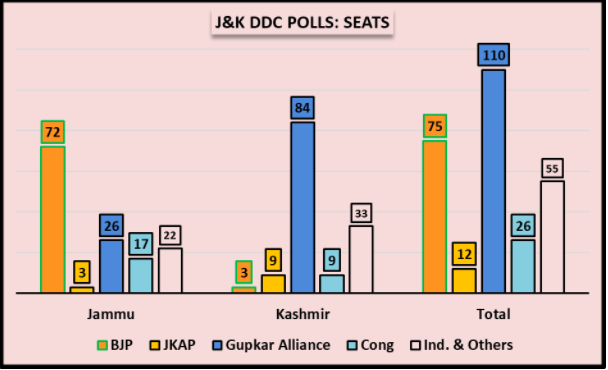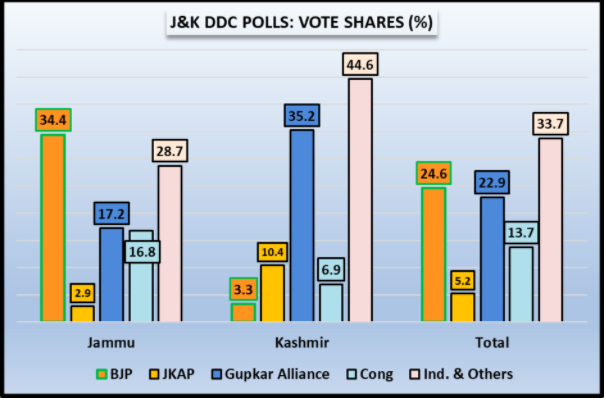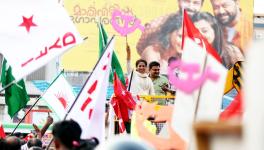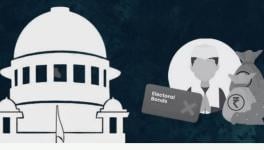J&K DDC Polls: Defeat for BJP’s Dreams and Myths
The recently declared results for the first District Development Council elections in the newly formed Union Territory of Jammu and Kashmir were hailed by the BJP and the sycophantic media as a victory for the ruling party. But a closer look shows that far from being a victory, the mandate was a clear rejection of the BJP in the Kashmir Valley and, more surprisingly, only a partial acceptance in the Jammu division.
Elections were held in 278 of the 280 wards; 14 in each of the 20 districts. The main contending parties/fronts were the BJP, the People’s Alliance for Gupkar Declaration (PAGD) – made up of seven Opposition parties – and the Congress. The BJP won a total of 75 seats and got a clear majority in just five districts while the PAGD got 110 seats and a clear majority in nine districts. The remaining six districts do not have a single party in majority. The Congress won in 26 seats and independents and others won in a whopping 55 seats. Srinagar district saw seven independents winning. The newly-formed J&K Apni Party (JKAP), said to be close to the BJP, won 26 seats.

The strong showing by independents (50) and others (5) reflects the fact that in these local body elections, local candidates carry much weight, and, in many wards, people prefer them to more established parties.
The seat distribution over the two divisions or districts – Jammu and Kashmir – shows that BJP won 72 of its 75 seats in Jammu and managed only three in Kashmir. These three seats too were won by the BJP because the PAGD had no candidate in two of these while in the third, both PDP and NC were contesting, giving the BJP a chance to sneak through.
PAGD, on the other hand, not only swept the Valley but also managed 26 seats in Jammu district while the Congress won 17 seats. Clearly, in Jammu division, the support for BJP remains limited to certain districts, mainly Jammu, Reasi, Kathua, Samba and Doda. These are all Hindu majority districts and the BJP has been strong in these areas earlier too. What is noteworthy is that it appears to have lost support even in these regions, with the Opposition parties gaining ground. This reflects the discontent in Jammu over its demotion to a UT and the continued neglect of the areas.
Vote Share Reveal Nuances of Support
The vote-shares received by the parties in these polls are a better barometer of how much support exists for various contending parties and their ideologies. As shown in the chart below, the BJP has ended up with an overall vote share of about 25% in the whole of J&K. Not too far behind is the PAGD, which garnered about 23% of the vote share while the Congress got about 14% of the votes polled.

Even if one was to add up the votes of JKAP with the BJP to represent those in support of the BJP’s policies vis-a-vis J&K – abrogation of Article 370 and the demotion and division of the state into two Union Territories – it comes to about 30% of the total votes polled, less than a third.
The parties opposed to the BJP’s policies – PAGD and Congress – together got nearly 37% of the vote share, decisively more than the BJP+ votes. Independents and others got about 34% of the votes. It is interesting to note that independents and others got about 29% votes in Jammu division while they got a massive 45% of the votes in Kashmir. If anything, this does represent a disenchantment with the PAGD (or its major constituents, National Conference and PDP).
Notably, the Mehbooba Mufti-led PDP, which was in an alliance with the BJP in 2015-2017 and ruled the state in that period, has suffered a setback despite having turned critic later. Overall, it could get only 3.9% of the votes in J&K, and in Kashmir specifically, it mustered only 8.8% votes. Compare this with the other big regional party, the NC, which got 16.3% votes overall and an 18% vote share in Kashmir Valley. Another regional outfit and constituent of PAGD, the J&K People’s Conference (JKPC) led by Sajjad Ghani Lone – who once flirted with the BJP but was against the abrogation of Article 370 and was put under arrest along with other regional leaders – managed to get 6.2% votes in the Kashmir Valley. Another constituent of PAGD, the CPI(M), managed to secure five seats, all in Kulgam district in southern Kashmir, in the hotbed of separatism.
The DDC polls were being seen as a referendum on the BJP’s iron-fisted policy towards J&K, starting with the abrogation of Article 370 which finished off the state’s special status and autonomy, and also its division into two Union Territories.
The results show that the pre-existing political polarisation continues – often overlapping the community-based division which itself was a gift by the BJP to the erstwhile state. However, the imaginary bubble that had been built up by sections of pro-Modi mainstream media about the peace and prosperity that now reigns in J&K, and the consequent support for BJP, has yet again been busted. Now, the troubled people await the Assembly elections – probably to be held in 2021 – to yet again express their political will
Get the latest reports & analysis with people's perspective on Protests, movements & deep analytical videos, discussions of the current affairs in your Telegram app. Subscribe to NewsClick's Telegram channel & get Real-Time updates on stories, as they get published on our website.
























